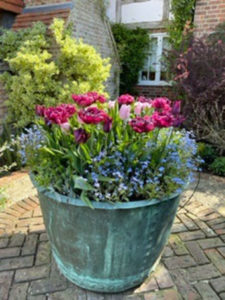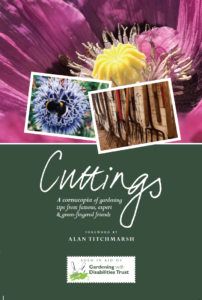What My Garden Means to Me

Today in my garden as it rains I feel the joy that gardening brings me. I looked at the daphne shrub and for a moment I forgot about how was I going to manage to pay my bills.
I live in social housing in Edinburgh, I am a 30 minute walk from the city centre but I am lucky to live in quite a green area and less than 10 minute walk to the sea.
I was on the waiting list for a flat, living in temporary accommodation from October 2014 until February 2019 as I had been made homeless twice, once in 2010 and again in 2014.
I am now the proud occupier of a ground floor flat with my cat, Klaus Nomi Malone, and a garden. At long last it really feels like I have a home.
Most social housing on ground floors are typically for people who have physical disabilities, but my flat couldn’t be adapted so when it came up I was so pleased to be offered it.
As it came with a garden, which I didn’t think I would ever have, and as I have had houseplants for many years (I got my first house plant at 6, a venus fly trap), I was very excited!
I have always enjoyed looking after my own house plants as well as guerrilla gardening in my friend’s garden.
However my plants had to be fostered out to friends while I was homeless. I have an ancient yucca, a cheese plant and many more in my sitting room.
Once inside was sorted I looked forwards to turning my attention to outdoors and my garden.

For those of you who don’t know, Scotland has very late Springs and very short Summers!!
My garden is also not easy because of its proximity to the coast and the lack of trees and shrubs nearby the wind whistles through the garden.
I used to love spending time in other peoples garden helping them plant up their gardens, but was a bit daunted by mine because it was so overgrown.
However a dear friend of mine Georgina came to visit last August and she bought a spade, saw and secateurs and then set about it hacking away the overgrown flower bed.
Which uncovered an uneven path (which has now been lifted and will shortly be relaid).
Georgina’s nieces, Adelheid and Frederika and her nephew Caspar came and helped clear with us. Then Georgina started a second bed before returning home and left me to continue what she had started.
Then Georgina’s sister, Germaine and her husband Mark visited and bought me split cane fencing to make a windbreak. To make the garden more sheltered from the fierce winds blowing off the Firth Of Forth.

Around the corner from my flat is a demolished building that had bricks all over the site so I spent time bringing the bricks home for the path and I had enough leftover to make a little retaining edge for the third bed because it was on a slope.
In October I planted my first plant, a thyme, a gift from Georgina, the thyme is not necessarily for cooking, but because I just love the smell of it. I love rubbing the leaves and smelling that unmistakeable scent.
Then I made a layered trench of bulbs, alliums, lilies and tulips at the bottom, above it grape hyacinths, snowdrops and my favourite bulb white hyacinths. I had to cover the soil with bark to stop the local cats using it as a toilet.
Then I planted some heathers before winter really kicked in.

That was it until after Christmas, when Germaine and Mark gave me some old Edinburgh slates from their renovated roof. I used them as edging, but because of the lack of foliage it made my garden look like I had created a pet graveyard! A roofer friend of mine, put slates on my shed roof, it’s only a tiny sentry shed, but it’s for my tools and I have some beautiful Indian brass padlocks on it too.
Arguably one of the most handsome sheds in Edinburgh!
I shared my gardening updates and got positive responses from my friends and followers. Some very generous people who follow me have even sent me wildflower and poppy seeds, Casablanca lily bulbs and even a Scrumdiddlyumptious Peony. Some of my neighbours living along my street stopped to chat as I worked in my garden and I found I was inspiring them to start planting.
I am ADHD, Autistic and live with depression and anxiety. At various times in my life I have become so overwhelmed and have been unable to leave the house…in some cases leaving my bed was difficult.
My garden has helped to change my life for the better. Even on bad days I look out the window and I get pleasure from what I see. Today I had a long lunch, but was back out at 2pm, I moved a Camellia which was getting whipped by the wind where I had planted it originally, continued with the raised bed building and then suddenly it was 6pm. The time just flies by in my wee garden.
I found out about the Gardening with Disabilities Trust Charity and applied for a grant. I was overjoyed to be successful and bought my small shed, tools, enriching compost, manure and of course plants, I was so pleased, it was a dream come true. I was able to buy plants such as hydrangeas, daphnes, clematis, honeysuckle, lavender, and of course one of my favourites, more thyme, this time I bought three, a lemon one, a variegated one and a creeping one.
Gardening really helps me to lose myself in the moment. Just today I was building a raised flower bed with no cement (we aren’t allowed to make permanent structures as a council tenant) using more of the reclaimed bricks. At 8 am this morning I looked out of my spare bedroom window then dashed out to get started and the next thing I knew it was 11.30am…and I hadn’t had my breakfast yet!

My garden is so rewarding especially when people comment and it makes me smile, whether they are walking past or whether it’s from someone on social media. It drives me on to make it as beautiful as I can.
I enjoy sitting in my garden now its progressing, some friends came over the other day and we sat in my garden and ate breakfast in the morning sunshine. I would say it was lovely, but lovely doesn’t begin to describe how I felt.
When I’m in my garden I feel a connection to my grandma. I spent a lot of time gardening with her when I was little. I have planted hebes and potentillia shrubs as I distinctly remember those being in her garden. Always covered with fat buzzing bumble bees.
There is nothing I like more than feeling my hands in the soil and I never tire of this in times of trouble. When I’m having a bad day I pop outside and see a new leaf emerging, pull up a weed or two or smell the scent of a flower which makes me feel like I’m caught up in the moment. There’s no past and no future. I’m just in the now.
I have found that people are so encouraging, this is my first ever garden and I love the fact I can watch the viola flowers, smell the daphne flowers and touch my thyme. I love watching the bees in my garden, it’s sad to know their numbers are declining. It always makes me smile when I see bees, hoverflies and butterflies fluttering around flowers I planted.

While I have been in my garden I have watched the yew tree across the road and the comings and goings of a pair of goldfinches who have nested in it and now I have seen the fledglings emerge, Something I would have missed before hiding indoors.
Recently I have been inspired to speak to local councillors and housing officers about the back green in the middle of the housing area, it has been used for fly tipping. Now we are at the early stages of planning a community garden. I showed them the area in the back green which I have sown the wildflower seeds and shown them what can be achieved. From my garden I have been talking to passing neighbours about having a community garden and before I had my garden I would never have been brave enough to encourage people to band together and now I am.
Not only has my garden bought me great joy making a wee haven for bees and butterflies but has empowered me to talk to neighbours and get a sense of community with my neighbours.

to hear about further progress in my garden please follow me on Instagram @that_jrf







































 Growing flowers & vegetables from seed is one of the simplest pleasures of the garden and an incredibly economical way to begin your gardening journey. By planting heirloom seeds, you are participating in an important link between the past generations who have saved these seeds for years & the future of food diversity.
Growing flowers & vegetables from seed is one of the simplest pleasures of the garden and an incredibly economical way to begin your gardening journey. By planting heirloom seeds, you are participating in an important link between the past generations who have saved these seeds for years & the future of food diversity.
 All seeds have a finite lifespan, however, some seed varieties will remain viable much longer than others. Onions, Chives, Okra, Fennel and Parsnip are some of the seeds with the shortest lifespan lasting around 1 year. Other seeds such as Celery, Eggplant, Lettuce, Tomatoes & Melons will usually have a lifespan up to 5 years if kept in ideal conditions, and in the middle you have seeds such as Brassicas, Carrots, Beets, chard Basil etc which will last around 3 years.
All seeds have a finite lifespan, however, some seed varieties will remain viable much longer than others. Onions, Chives, Okra, Fennel and Parsnip are some of the seeds with the shortest lifespan lasting around 1 year. Other seeds such as Celery, Eggplant, Lettuce, Tomatoes & Melons will usually have a lifespan up to 5 years if kept in ideal conditions, and in the middle you have seeds such as Brassicas, Carrots, Beets, chard Basil etc which will last around 3 years. 










